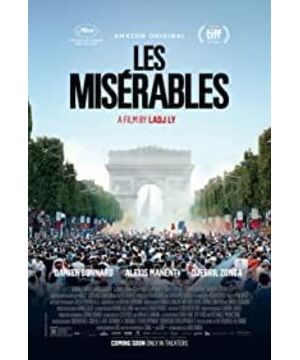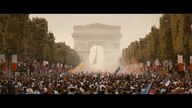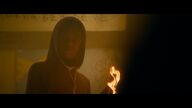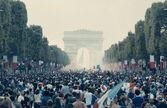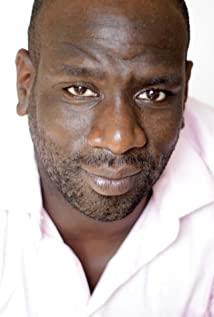Translated in SQ
Edit mantou
After watching Ladj Ly’s feature-length debut "Les Miserables" (hereinafter, unless otherwise specified, all refer to the film and not the novel.-Translator's Note), we will be thrown on the edge of the cliff a feeling of. This film not only erupts with eager, scorching, and indignant energy, it is also very rich in content, which is worthy of careful disassembly.
The first advantage of "Les Miserables" lies in its excellent description ability and the quality of a teaching film. This is the first time people have ever seen a residential area (cité") displayed on the big screen—especially a residential area in Montfermeil.
The film does not take the conflict between the youth and the police as the core of the film, but conducts a political study on this seemingly non-stop residential area as a social organization. The daily operation of the residential area relies on the balance of power of all parties. There are the police, the "mayor" who actually manages the affairs of the residential area, believers of various religions and businessmen, and the real mayor who represents the government is absent in the film.
The story of the film takes place on a summer day with a temperature of 35° [same as another important film about riots-Spike Lee’s Do the Right Thing (1989)]. Also absent is School: Children roam the streets all day. The police is the only representative of public power that appears in the film. However, it is not an independent force. It is organized in a system with other power institutions.
This is a Yalta style place. The film spent a lot of pen and ink to show us the social organization of the residential area. The aerial shot of the residential building from the drone's perspective and the frontal shot of the market (different color blocks make it like an abstract painting) delineate the geographic location of the residential area. limit. John Carpenter and Akira Kurosawa will always show the audience a clear map of the space, so that the audience can understand the path from one place to another. The difference is that "Les Miserables" is not going to let us be in this space. To discern the direction, it only shows us one by one independent areas with symbolic significance.
In the film, we followed Damien Bonnard (Damien Bonnard), who had just left Cherbourg (port city in northwestern France) to work at the police station in the town of Dreamfermeil, and visited a series of locations. Djebril Zonga (Djebril Zonga) of the BAC and his boss Chris (Alexis Manenti) are in charge of the hair cream. In addition to the realistic description and the impression of the teaching film, the film's drastic narrative efficiency is surprising. First of all, Raj Lee has inserted a small comedy in the film: the dialogue between the police is dizzying, all forces are enemies and friends, the "mayor" is wearing a "mayor team" football shirt... all of this All condensed in the small street theater of the film. Secondly, the film's story takes place in one day, following the trinity of classical tragedies.
In this way, it becomes very important to clarify how the situation developed to the point where the police accidentally injured a child (the police fired a flash shot on a child) and how various forces in the residential area tried to quell the incident. challenge. Around this tragedy, the film wanders between different tones with rare control.
The film could have followed the gaze of the rookie policeman who was destined to be teased by his new colleague, but Raj Lee also included the boy with glasses manipulating the drone and the compassionate black policeman ("good policeman"). ) And the neurotic white policeman ("bad police") and other characters. He narrates from their own perspectives, and then reverses the audience's assumptions about the actions of these characters when they first watch the movie. Only in this way, this space and the residents here are not just rookie policemen—that is, they look like in the eyes of the audience's agents. This means of expression gives the film the characteristics of a documentary. For example, when Guarda enters the apartment, the audience leaves the "hair balm", but together with Guarda learn about the self-organized mutual loans among residents.
Raj Lee knows that he is in a delicate situation. He wants to break all the established imaginations of people here. He constantly eliminates all clichés in the film (not talking about drugs, not talking about terrorism, and not pursuing excessive audiovisual stylization).
"Les Miserables" is the opposite of "The Wandering Dheepan" (Dheepan, 2015). This Jacques Odia’s film drama is simple. The location of the story is limited to two buildings. Drug dealers trade on the roof. Everything is in line. The imagination of the Western world meets the requirements of genre writing in dramas and is very artificial.
Raj Leigh has abandoned this set, which is very different from those outside directors who are full of exotic imaginations about the place. Most notably, Raj Li rejects the self-indulgence of a small pattern. He embraces the altérité between individuals with both hands: not only the Normans who have just come from Cherbourg, but also Jeanne Ba The senior police officer played by Jeanne Balibar, wearing a plus-size uniform, suddenly appeared amidst a burst of laughter, which was beyond everyone's expectation. The design of this short-lived character is definitely not just for Ballybal to appear on the scene. This character assumes a corresponding descriptive function. The film uses this character to satirize the ridiculousness of men's masculinity.
The film also gave the Gypsies a place. They carnival in the streets, like announcing that a circus is coming. The concrete "ignition" in this scene also "detonated conflict" in the narrative. In the face of the frantic wave full of primitive wildness they set off, the most intense excitement seemed calm as water! They warmly welcomed the police to join. The camera did not regard the police as the "other" in the residential area. They were imprisoned in this residential area from the inside out, from the body to the heart, just like all poor and poor people. Raj Lee showed us how these policemen live after get off work is no different from ordinary people. The film is very friendly to all audiences, and it should be able to reap the love of the audience as we wish. This film is "complete", it is born out of a commonality, not a separation: just like Raj Li’s experience of the unprecedented unity of all French people before and after the 2018 World Cup finals, it reminds people of the 1998 World Cup in France. myth.
The film could have broken the stereotype as its own responsibility and stopped at the description of realism, but it chose to enter another dimension: the film introduced several extraordinary elements and opened the story. This fiction is very impactful, and because it is deeply rooted in reality, the film transcends simple realism. The fictional and symbolic nature of the film is condensed in the representative of the supernormal element-the lion, which is the source of all imbalances. In the beginning, the little thief who stole the chicken turned into the thieves who stole the lion. This design casts a fantasy color on the film. This fantasy element in daily life resonates deeply with Victor Hugo's creation (feeding a lion is very similar in temperament to living in a Bastille elephant).
The core scene of the film is the confrontation between the child and the lion in the cage. The boy suffered life threats and humiliated his dignity (he wetted his trousers). We witnessed his transformation in this struggle: we can no longer look at the face that was disfigured by the flash bomb with the same eyes as before. The mark of a lion was branded on his body. His tousled hair and T-shirt with a tiger pattern exudes fate (a carton decorated with a lion pattern appears in the background of a scene).
This story portrays the moment when his appearance was destroyed in a true sense as the moment of his "transfiguration" (transfiguration), in which he was reborn as a lion in fear. He became strong, upright, and wild. This day may indeed be the worst day in the rookie’s life, but this is the day when the child fell into hell: he was left to die, dragged around like a package, and a beast Hand in hand...what else can he fear? The strong emotion contained in this moment cannot be ignored. The police wanted to leave the boy to feed the lion, "it was his fault" and "it was he who fell."
These few words quoted from Hugo have faded out of our memory, but at this moment it is like a whip: "Whose fault is it?-it is my fault." Our Gavroche wept heartbreakingly. Replied. We witnessed a ceremony to expel humanity. Although he said this was really to dispel the clever words of others, there was no real heart in it. He was still among a group of children. He was lying on an abandoned sofa, sitting on the roof of a tall building in the residential area, thinking for a long time. Our hero of the rebellion is here. This transformation is different from a superhero wearing a uniform, of course, except for another social scum-the clown. He also has the twisted face described by Hugo in "The Laughing Man", and similarly, he also detonated a riot.
In this movie, which seems to be moving forward, but spinning like a flashlight ball in a disco, there is another image of a child: the person who has witnessed everything. He has a shy personality and always hides for observation, but his role is crucial because he is "seeing": he is watching through his glasses, drone and the peephole in the corridor door. He is also a rebel because he refuses to hand over his own images to the police.
Before the start of the ambush, in the scene of the children playing with water guns, the continuous shaking of the handheld camera gave people a strong sense of anxiety. The children were so closely connected to each other, giving people a strong emotional impact. Ignition is the last step before the rocket lifts off. The film went crazy in a riot, and we haven’t seen it since Jean-François Richet’s "My Town Is Going to Explode" (Ma 6-T va crack-er, 1997) Such a scene appeared on the screen.
This children’s rebellion is closely related to all important contemporary issues. It reminds us of Albert Cossery's "Albert Cossery" mentioned by Godard at the end of "Livre d'image" (Livre d'image, 2018). The rebelling children in "Une ambition dans le désert" (Une ambition dans le désert). Once again, children like Greta Thornberg, who gave a speech at the United Nations on the topic "How dare you?", took action. The children's gazes are beyond themselves. They look at us as if they are asking: "Look at what you did?" Their gazes are daunting, but people should be afraid. Otherwise, how can they change.
The boldness of "Les Miserables" (which dares to name itself after a classic French literary masterpiece!) is that it does not try to mix the "genre" (genre), but chooses to upgrade to the "registre" (registre). There are obvious differences. Nowadays, even the best French films are naively viewing "genre" as another alternative parallel to naturalism. In the past, naturalism was just an image that could "give people a sense of reality" in reality, so it was actually a comic-style interpretation of reality. In the name of so-called immanence, naturalism excludes all the elements of fantasy, exaggeration, and preaching, and has successfully concealed many ideological prejudices.
On the other hand, the type is mostly imported from the United States. It is a set of material, image and ideological tools. It creates hallucinations, mistakenly thinking that it can be used to express the truth about our lives... "To create a sense of reality" is the same. Like "genre creation", they are two sides of "false". If you want to discuss life sincerely, you must recombine reality and imagination. To achieve this goal, "Les Miserables" does not resort to "types", but uses "tonality". The film mobilizes a variety of feasible rhetorical devices in a new way, jumping from one "tone" to another. It uses the image of a beast to be both instructive, comic, tragic, fantasy and The epic-in-one approach elegantly achieves this transformation.
The clues of the police are mixed with elements of teaching color, tragedy and comedy, while the transformation from a child to a lion is in a fantasy story (a lion in a cage) and sad fate ("Whose fault is this?-it is my fault.") Explore to a deeper level in the combination with the heroic epic. The ending riot is not just the end of the plot. The audiovisual presentation is both like a hero story in a pocket book, but also like a legend: there are boiling crowds, barricades and roadblocks and a rebellious hero. "Les Miserables" is a film lesson, which takes us away from the commonplace common to many contemporary film and television works.
The residential area is just an ordinary place that is no different from other places, or is it on the contrary, with an indelible particularity? The tension created by these two opposing concepts throughout the film is another reason why the film is so exciting, and it is also a common paradox encountered in contemporary society when portraying suburban life. The bow must be opened on both fronts. On the one hand, it is necessary to break the stereotype and let people see that this is not a place of exile, and that this place is no different from the children here.
In the film, the scene where a boy and a group of girls quarrel with a group of girls over a drone reflects this concept. In addition, this is also a successful film directed by Grand Corps Malade and Mehdi Idir (Mehdi Idir). I am not a poor student" (La Vie scolaire, 2019). This film depicts campus life and complements "Les Miserables".
We must reunify the expression of the suburban space into the overall context of French cinema, and cannot express it as an exotic or threatening "other place", nor can we present "it" as a "territoire" (territoire). ) (How can there be such shameless remarks?). On the other hand, let people see that this place is no different from other places.
The reason why it is impossible to escape here is that people have chosen to abandon it; the reason why it is swept by poverty is because the economic vitality is stifled by closure. Cherishing does not mean rejecting change. Even if what the people in the film experience is not the kind of wandering on the streets described in Les Misérables by Hugo, it is still justified to use Hugo's work as a reference. Hugo once said, "Open a school, and you can close a prison." Raj Lee, the film director and educator, really opened the school. (See interview).
Someone fell: whose fault was it? Who did Raj Lee target? It's the government, and all levels of government from the country to the region to the municipalities in the film are absent. We can watch Raj Lee’s short film "365 Days of Clichy-Montfermeil" (365 Jours à Clichy-Montfermeil, 2006) in his short film after the riots in France in 2005. How is the mayor in real life? How did the evading camera get caught by Raj Lee. The first thing Raj Li said when he participated in the Cannes Film Festival was that he hoped Macron could watch "Les Miserables" and regarded it as a film specially made for him, just like François La François Ruffin's book "A France You Don't Know" (Cette France que tu ne connais pas) is the same. The last frame of the film is a hesitant eye. The black screen fades out at the end of the film. The black color swallows the frame a little bit until only one face is left, much like the burning effect of paper or film-Raj Lei We can understand his hesitation between the two choices: sometimes, we must find a way to stop everything; but sometimes, we have to give reality a chance because we don't want to resort to violence.
Notes:
The "cité" here is not a specific administrative concept, but a historical and social concept. It mostly refers to the "Priority Urbanization Area" policy (ZUP) implemented by France in the 1960s to solve the housing crisis in large cities. , Many low-cost residential areas have been established on the outskirts of big cities. Due to the government's failed urbanization policy, these areas have become a gathering place for low- and middle-income people, and the unemployment rate is very high. Coupled with the lack of public transportation and other public facilities and few job opportunities, these areas are disconnected from the outside world, and illegal crimes are becoming more and more rampant. This article temporarily translates it as "residential area".
The city of Montfermeil is located in the eastern suburbs of Paris, where the Thenardier Tavern is located in Hugo's Les Misérables.
This paragraph compares the image of the boy Gavroche (Gavroche) in "Les Miserables" by Hugo from the source of the title and the characters in the film. The previous article mentioned that Gavroche lived in the sculpture of the Bastille elephant in the comparison of the commonality of the fantasy elements between the film and the novel. The two sentences here are quoted from the first volume of the fifth volume of "Les Miserables", "Gavro What Goes Out" (People's Literature Publishing House, translated by Li Dan), tells the ballad that Gavroche sang before his death in the barricade battle:
The Nanterres are ugly,
This can only blame Voltaire (C'est la faute à Voltaire)
The big pustule of the Paraiso,
This can only blame Rousseau. (C'est la faute à Rousseau)
...
I fell down,
This can only blame Voltaire;
The nose fell into the creek,
This can only complain... (C'est la faute à...)
From October 27 to November 17, 2005, social riots broke out in the suburbs of Paris for 20 days. The cause was that two North African boys in Clichy Subwa, a suburb of the city, were accidentally electrocuted while evading police chase. The local teenagers started the riots first, then spread to many areas with more black immigrants, and spread to other large French cities a week later. Nearly 10,000 vehicles and many buildings across the country were burned down, and more than 2,800 suspects were arrested and imprisoned.
François Ruffin is a French journalist, writer, documentary director and politician. In February 2019, he posted a video on the Internet after the publication of "A France You Don’t Know", saying that the writing and preparation process of this book before publication is strictly confidential because "a boxer will not notify in advance before he moves. "His opponent", he expressed the hope that this book is also a hard punch, and it is best to hit President Macron.
View more about Les Misérables reviews


